Hi, everyone!
Depending on who was in charge, Belgium and the Netherlands have been part of the same country or separate countries. Right now, they are separate countries, each with their own king, but they celebrate some of the same holidays. May 1 is Labor Day, and this year it was a four day holiday. So our visits to the Belgian cities of Ghent and Bruges on Friday were like our visits to Antwerp and Brussels on Thursday. There were lots of tourists and many stores and offices were closed.
On Friday morning, we visited the historic center of Ghent. Belgium is divided into three parts by culture and language. Ghent is the capitol of the Flemish region. Ghent was a very important city in the Middle Ages. In Europe, only Paris was bigger! Ghent is a university town, and students celebrate the end of the semester by throwing their shoes over wires or cables above the street. We walked past St. Michael’s church and St. Nicholas church and visited St. Bavo’s cathedral. St. Bavo’s cathedral has a very famous altarpiece painted by Jan van Eyck, called Adoration of the Lamb. People aren’t allowed to take pictures of the altarpiece, but I got a postcard to send to Hitsuji-san, Karin-chan’s lamb. The inside of the church is very pretty, but lots of people were trying to see the altarpiece at the same time! It felt like Kings’ Day all over again!
After we walked around Ghent, we took a bus ride directly to Bruges. Bruges was also an important port and manufacturing city in the Middle Ages, but now it is mainly a tourist destination. The old city is a World Heritage site, just like some of the temples I visited in Thailand. Parts of the medieval city wall and gates are still standing, and there are lots of canals, like Amsterdam. The people of Bruges have been required to keep at least 52 swans in the city as punishment for something that happened in 1488. We stopped at Our Lady church, which is the biggest brick church in Europe. That church has the only statue by Michelangelo that was sold outside of Italy in his lifetime. The Pope in Rome asked Michelangelo to make a statue of Mary and baby Jesus, but when it was done, the Pope didn’t want to pay the asking price. So Michelangelo sold it to some visiting Flemish merchants, who took it back to Bruges. We walked through the market square, then we went to the square with the town hall. Our guide pointed out all the different architectural styles of the buildings. He said the town hall square was a complete lesson in art history!
It was very windy, so Grandma and Grandpa walked around until they found a sheltered bench in a park to eat lunch. Then they took me to the post office, so I could mail my postcard to Hitsuji-san. After that, we took a cruise on the Bruges canals. There were lots of low bridges! On the way back to the bus, our guide showed us a cluster of houses tucked behind the main street down a very narrow alley. These houses were built so poor or elderly people would have a safe place to live. It’s a very peaceful place
When we returned to the Amadolce, it was already moored back in the Netherlands! After dinner, the chefs served a buffet of Belgian desserts. They all looked yummy, but there were too many to try everything! After sunset, Grandma and Grandpa took me to visit the bridge. The captain explained how he steers the ship and how he knows where he is. I got to sit in the captain’s chair with the first officer, then I helped the captain adjust the propellers on the two engines so we went in the right direction.
On Saturday morning, we arrived at the Dutch town of Willemstad. It was cold and windy, so everybody had to wear coats and hats. Willemstad still has its complete city wall in the shape of a seven-point star and there’s a moat all the way around the wall that opens to Hollands Diep, a very wide river. The Reformed Church in Willemstad has a very nice pipe organ, and we attended a recital there.
After the recital, Grandma and Grandpa took me for a walk around the city wall. It’s very pretty! Along the way, we saw a flock of sheep that is moved from one area to another to keep the grass short. Then we looked at the windmill and harbor. The windmill in Willemstad is used to grind grain into flour, rather than pumping water out of the fields. I got to see the control wheel for closing off a small canal, then I made friends with the cannon in front of the old town hall.
After lunch, the Amadolce cruised for a couple of hours to reach Kinderdijk. It was too chilly to watch from the open sundeck, so Grandpa and I sat in the lounge instead. Kinderdijk is a World Heritage Site for traditional windmills. There are nineteen spaced along canals, and many of them were at work pumping water up to the river from the fields. One of the working windmills is also a museum, so we got to go inside to see how the windmill works. While we were there, the windmill vanes began turning faster and faster! We also took a look at the modern equipment that has been built to help out, in case the traditional windmills can’t keep up with the amount of water that needs to be pumped out of the field. Then we went back to the Amadolce and the Amadolce sailed back to Amsterdam.
On Sunday, when we got up, the Amadolce was moored exactly where it had been when we boarded last Monday! After breakfast, all the passengers got on busses to go to Keukenhof gardens. I was glad we had been last Sunday, too! Some of the flowers I liked last week were already gone.
There were lots of things to see at Keukenhof this week that I didn’t see last week. For a brief period in the 1630s, tulips were so popular that people spent fortunes to buy a single bulb or flower. That financial bubble burst, but tulip growing continued. The greeter at the gates to Keukenhof is dressed the same way women were during tulip mania. I got to make friends with the statue of the man who first brought tulips to the Netherlands, read his story and see some of the first tulip varieties that were imported. I found a big chess set in a gazebo and spent some time in the playground.
Some flowers, like the azaleas and rhododendrons, were prettier this week than last week. The orchid display in the Beatrix pavilion was just like last week. Can you find me in the orchid photo? There were new displays of hydrangeas and amaryllis and potted daffodils in Willem-Alexander pavilion. This week, we had time to stop for a traditional Dutch snack. I made friends with a very colorful cow and had time to listen to the mechanical organ near the entrance gate.
When we got back to the Amadolce, I noticed there was a big chess set on the sun deck, too! We had lunch, then everybody went off for their final tours. Some people went on a tuk-tuk tour of Amsterdam, but Grandma and I had enough tuk-tuk riding in Bangkok!
Grandma and Grandpa and I went to Beemster to learn to make cheese. After the rennet curdled the milk, I helped Grandma stir to break up the curds so the whey (liquid) could come out. When it was time to pack the curds into molds, I let Grandma do it! I was a good helper with the weights on the cheese press. In four weeks, our cheese should look just like the gouda that was on display.
When we came back from cheese making on Sunday evening, we turned in our boarding passes for the very last time. On Monday morning, it was time to pack up and leave Amadolce. I made sure to say goodbye to my friend Reka-san! Grandma and Grandpa and I walked to the train station and took the train back to the airport. I had a snack of Dutch cheese on the flight back to the US, and we even arrived early! The lines for immigration and customs were both short, so we had plenty of time to catch our final flight back to Rochester.
Tuesday morning, Grandma had to go to work, and she took me along to see her new office. I stopped to see my dogwood tree friends in the courtyard. I was happy to see that I hadn’t missed seeing them in bloom. Spring in Rochester waited for me to get back!
Love,
Lion-san




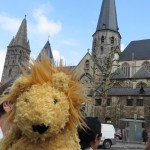
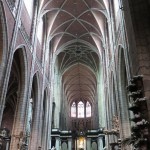

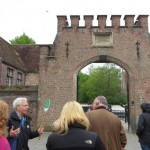
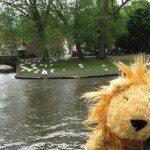



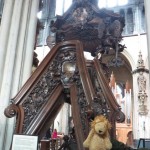
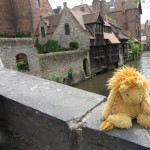
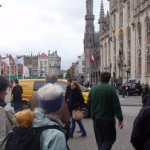
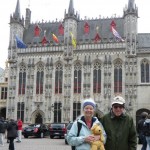


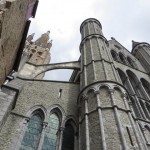



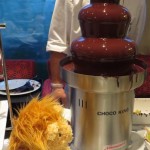
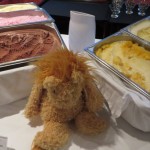
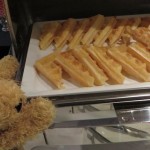


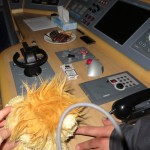
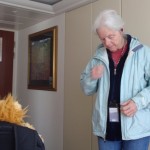

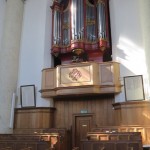

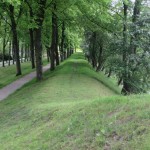

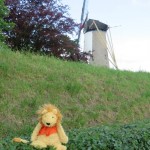
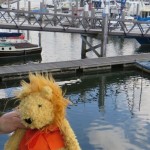
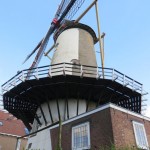

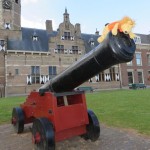
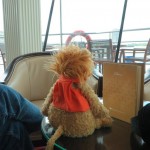

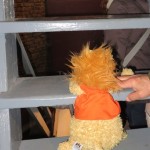




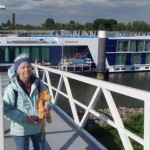




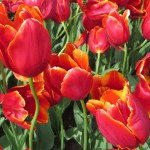



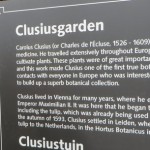






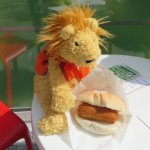

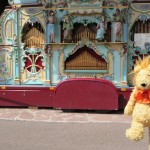
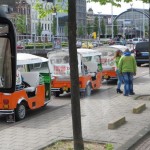



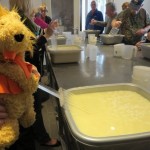
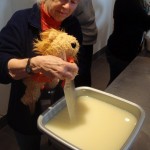




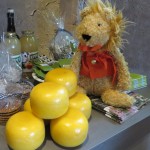





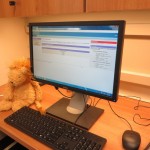
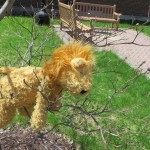
Welcome home! It looks like you had a very interesting time. It seems like you got a good lesson in architecture. Did you win the chess games? Moose-san wondered if there were good aquatic weeds in any of the canals.The desserts on the ship looked yummy. Nancy-san said she learned to make cheddar cheese but she hasn’t made any for us.